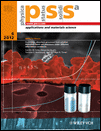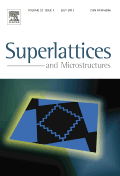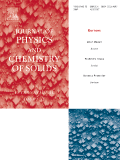
PHYSICA STATUS SOLIDI A-APPLICATIONS AND MATERIALS SCIENCE
Scope & Guideline
Driving progress in condensed matter research.
Introduction
Aims and Scopes
- Materials Characterization:
The journal extensively covers the characterization of materials, including their structural, optical, electrical, and magnetic properties. This involves techniques such as X-ray diffraction, electron microscopy, and photoluminescence. - Device Fabrication and Performance:
Research on the fabrication and performance of electronic, optoelectronic, and photonic devices is a core focus area. This includes studies on solar cells, LEDs, and sensors, emphasizing the relationship between material properties and device efficiency. - Nanostructured Materials:
The journal highlights the synthesis and application of nanostructured materials, including nanoparticles, nanowires, and thin films. These materials are explored for their unique properties and potential applications in electronics, energy storage, and catalysis. - Emerging Materials:
Research on emerging materials, such as perovskites, organic semiconductors, and two-dimensional materials, is increasingly prominent. The journal aims to advance the understanding and application of these materials in next-generation technologies. - Sustainable and Green Technologies:
The journal encourages research that focuses on sustainable materials and processes, including the development of eco-friendly materials, recycling methods, and energy-efficient devices.
Trending and Emerging
- Advanced Photovoltaic Technologies:
There is a growing trend in research focused on innovative photovoltaic technologies, particularly perovskite and tandem solar cells, which promise higher efficiencies and lower production costs. - 2D Materials and Heterostructures:
The exploration of two-dimensional materials, such as graphene and transition metal dichalcogenides, is on the rise. These materials are being investigated for their unique properties and applications in electronics and optoelectronics. - Quantum Computing and Quantum Materials:
Research into quantum materials and their applications in quantum computing is emerging as a significant theme, with studies focusing on materials that exhibit quantum coherence and entanglement. - Energy Storage Solutions:
There is an increased emphasis on materials for energy storage applications, particularly in the development of high-performance batteries and supercapacitors that are crucial for sustainable energy systems. - Biomaterials and Medical Applications:
Research on biomaterials for medical applications, including drug delivery systems and bio-sensors, is trending as the field of materials science increasingly intersects with biomedical engineering.
Declining or Waning
- Traditional Bulk Materials:
Research related to traditional bulk materials, such as metals and ceramics, has seen a decline as the field shifts focus towards nanostructured and advanced materials with tailored properties. - Conventional Semiconductor Technologies:
Studies centered on established semiconductor technologies, such as silicon-based devices, are decreasing as research moves towards novel materials and architectures, including organic and perovskite semiconductors. - Static Device Applications:
Research focusing on static applications of materials, such as passive components, is waning as the demand for dynamic and multifunctional materials increases in modern applications. - Low-Temperature Processing Techniques:
There is a noticeable decline in studies using low-temperature processing techniques as researchers increasingly explore high-temperature methods that enhance material properties and device performance.
Similar Journals

REVIEWS ON ADVANCED MATERIALS SCIENCE
Pioneering Discoveries in Advanced MaterialsREVIEWS ON ADVANCED MATERIALS SCIENCE, published by De Gruyter Poland SP Z O O, is a preeminent open-access journal dedicated to disseminating cutting-edge research in the fields of condensed matter physics, materials science, and nanoscience. Since its inception in 2003, the journal has established itself as a crucial platform for scholars and practitioners to share innovative insights and advancements, achieving a commendable Q2 ranking in its respective categories for 2023. With its headquarters in the Russian Federation, the journal is not only committed to expanding the frontiers of scientific knowledge but also emphasizes inclusivity through its open-access model, which has been in effect since 2019, enabling universal access to its high-quality content. With an impactful standing illustrated by its Scopus rankings—136th in Condensed Matter Physics and 186th in General Materials Science—REVIEWS ON ADVANCED MATERIALS SCIENCE stands as a vital resource for researchers, professionals, and students eager to engage with contemporary discussions and discoveries in materials science.

Journal of Ovonic Research
Fostering Interdisciplinary Insights in Ovonic Research.Journal of Ovonic Research is a distinguished publication dedicated to advancing the fields of electronic, optical, and magnetic materials. Published by VIRTUAL CO PHYSICS SRL, this journal offers a platform for researchers to share innovative findings and developments that push the boundaries of technology and materials science. With an ISSN of 1842-2403 and an E-ISSN of 1584-9953, it provides an important service to the academic community, particularly within Romania and beyond. Despite its recent inception in 2011, the journal has gained traction in the academic landscape, reflecting a Q4 quartile ranking in crucial categories such as Electronic, Optical and Magnetic Materials, as well as in Physics and Astronomy. The Scopus rankings further underscore its positioning, ranking within the 25th to 37th percentile across various disciplines, making it a valuable resource for professionals and students alike. Although the journal currently operates on a non-open access basis, it remains committed to exploring the latest advancements in materials science, encouraging interdisciplinary collaboration and fostering a deeper understanding of surface, coating, and film technologies. As the field evolves, Journal of Ovonic Research stands as a beacon for scholarly communication, bridging the gap between research and practical application.

Frontiers in Materials
Pioneering Transformative Applications in Materials Science.Frontiers in Materials, an esteemed journal published by FRONTIERS MEDIA SA, is a leading platform in the field of Materials Science, with a notable impact factor placing it in the Q2 category of its discipline as of 2023. Since its establishment as an Open Access journal in 2014, it has fostered considerable academic exchange, allowing researchers from around the globe to share their innovative findings and insights. Based in Lausanne, Switzerland, this journal not only emphasizes high-quality peer-reviewed articles but also prioritizes rapid dissemination of research, as evidenced by its commendable Scopus ranking of #62 out of 196 in Materials Science (miscellaneous). By consistently striving to bridge the gap between academia and practical applications, Frontiers in Materials serves as an invaluable resource for researchers, professionals, and students seeking to delve into cutting-edge advancements and transformative applications in materials science.

Crystals
Unlocking the Secrets of Crystalline MaterialsCrystals is a premier open-access journal, published by MDPI since 2011, that focuses on the multidisciplinary fields of chemical engineering, condensed matter physics, inorganic chemistry, and materials science. With its E-ISSN 2073-4352, the journal is headquartered in Switzerland, and actively contributes to the global scientific community by facilitating the dissemination of high-quality research. Ranking in the Q2 quartile across multiple categories, including Chemical Engineering (miscellaneous) and Materials Science (miscellaneous) for 2023, Crystals provides a platform for innovative studies that span from fundamental research to practical applications. The journal's commitment to open access ensures that groundbreaking findings are readily available to researchers, professionals, and students alike, fostering an environment of collaboration and knowledge sharing that is essential in advancing the scientific understanding of crystalline materials.

PHYSICS OF THE SOLID STATE
Illuminating the Path of Interdisciplinary ResearchPhysics of the Solid State is a distinguished journal published by Pleiades Publishing Inc., focusing on the rapid advancements and fundamental research in the realms of condensed matter physics, electronic, optical, and magnetic materials. With an ISSN of 1063-7834 and an E-ISSN of 1090-6460, this journal serves as a crucial platform for disseminating high-quality research findings, insights, and reviews essential for both academic and industrial professionals in the field. As of 2023, its Scopus ranking places it in the 26th percentile for both Condensed Matter Physics and Electronic, Optical and Magnetic Materials, reflecting its evolving influence and contribution to the scientific community. Although currently classified in the Q4 quartile, the journal aims to foster interdisciplinary dialogue, improve research visibility, and enhance its impact on contemporary scientific challenges through rigorous peer-reviewed articles and focused special issues. Despite its traditional model of access, it continues to play a pivotal role in engaging researchers and fostering innovation in solid-state physics.

JOURNAL OF THE CERAMIC SOCIETY OF JAPAN
Unveiling the future of materials science and ceramics.Journal of the Ceramic Society of Japan is a prominent peer-reviewed journal dedicated to advancing the field of ceramics and composites. Published by Ceramic Society Japan - Nippon Seramikksu Kyokai, this journal serves as a critical platform for innovative research and development within the realms of materials science and condensed matter physics. Established in 1988, it converges a rich history of contributions and anticipates further advancements through 2024. With an emphasis on interdisciplinary research, the journal ranks in the third quartile in multiple categories, including Ceramics and Composites and Materials Chemistry, promising valuable insights for academics and industry professionals alike. Despite its robust academic standing, the journal currently operates without open access, reflecting the challenges of disseminating specialized research in today's competitive landscape. Whether you are a seasoned researcher or an aspiring student, Journal of the Ceramic Society of Japan offers essential resources that can enhance your understanding and foster innovation in ceramic materials.

MATERIALS SCIENCE-POLAND
Unveiling New Possibilities in Materials ScienceMATERIALS SCIENCE-POLAND, published by SCIENDO, is an esteemed open access journal dedicated to the rapidly evolving field of materials science. Since its inception in 2002 and transitioning to an open access model in 2015, the journal has been a vital platform for researchers and professionals to disseminate their findings and contribute to the scientific community. With an ISSN of 2083-134X and an E-ISSN of 2083-134X, it spans a comprehensive range of disciplines, focusing on condensed matter physics, materials science, and mechanical engineering among others. In the 2023 rankings, it holds a position in the Q4 and Q3 quartiles across various categories, showcasing its relevance and ongoing contribution to these fields. Researchers benefit from its accessibility, enabling wider reach and engagement with contemporary topics in material innovation and applications. As the journal continues to evolve until 2024, it remains a cornerstone for scholars looking to advance their knowledge and research in materials science.

SUPERLATTICES AND MICROSTRUCTURES
Innovating through cutting-edge research in condensed matter physics.SUPERLATTICES AND MICROSTRUCTURES is a premier journal dedicated to the exploration and dissemination of cutting-edge research in the fields of Condensed Matter Physics, Electrical and Electronic Engineering, and Materials Science. Published by Academic Press Ltd - Elsevier Science Ltd, this journal has established itself as an important platform for scholars and industry professionals to share their findings related to the design, fabrication, and application of superlattices and microstructured materials. With a commendable impact factor reflected in its rankings—positioned within the top quartile in Physics and Astronomy as well as Electrical and Electronic Engineering—it offers high visibility and influence in the academic community. The journal has covered significant contributions from 1985 to 2022, although access options have transitioned, making staying current essential for researchers and practitioners alike. This journal not only serves as a repository of knowledge but also fosters collaboration and innovation in materials science and related disciplines.

Journal of Advanced Dielectrics
Pioneering Research for Tomorrow's TechnologiesThe Journal of Advanced Dielectrics, published by World Scientific Publishing Co Pte Ltd, is a pivotal open-access platform since 2014 dedicated to advancing research in the fields of dielectrics, ceramics, and composites. Based in Singapore, this journal aims to bridge the gap between theoretical developments and practical applications in Electrical and Electronic Engineering, Condensed Matter Physics, and Electronic, Optical, and Magnetic Materials. With an impressive classification in the 2023 Quartile Rankings indicating its significance within its categories, and notable Scopus Rankings that highlight its impact and relevance, this journal serves as a vital resource for scholars and professionals committed to cutting-edge research and innovation. As it continues to flourish through the converging years from 2015 to 2024, the Journal of Advanced Dielectrics stands as an essential conduit for the dissemination of knowledge in advanced material sciences, making it an indispensable asset for today's research community.

JOURNAL OF PHYSICS AND CHEMISTRY OF SOLIDS
Illuminating the Science of SolidsJOURNAL OF PHYSICS AND CHEMISTRY OF SOLIDS, published by Pergamon-Elsevier Science Ltd, is a distinguished international journal that has been at the forefront of disseminating cutting-edge research in the fields of physics, chemistry, and materials science since its inception in 1956. This journal, which is recognized for its high impact in the Q2 category across multiple subjects—including Chemistry (miscellaneous), Condensed Matter Physics, and Materials Science—serves as a vital platform for researchers, professionals, and students to engage with significant advances in solid-state physics and chemistry. With Scopus rankings placing it in the top 15% of its field across various domains, the journal plays a crucial role in shaping the scientific dialogue surrounding materials properties, synthesis, and applications. Although it does not currently offer open access options, the presented research is widely recognized for its quality and relevance, ensuring that published works contribute meaningfully to ongoing scholarly discussions.